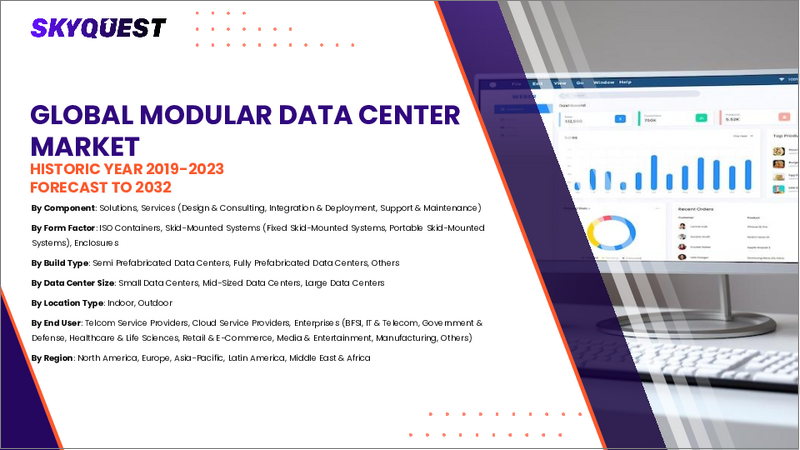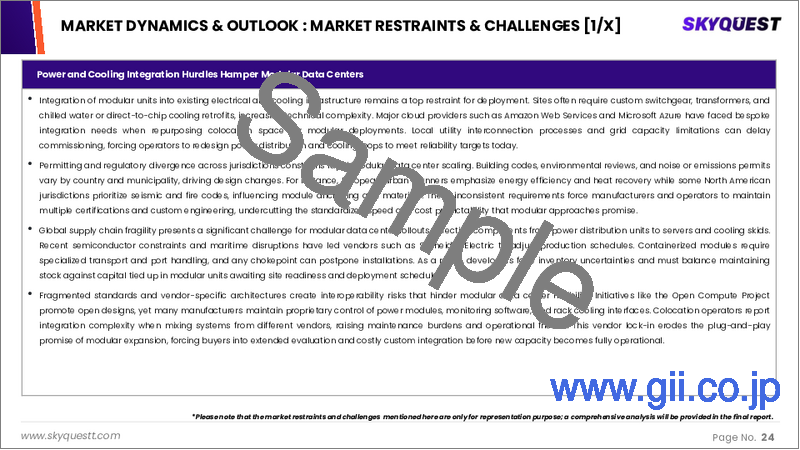|
|
市場調査レポート
商品コード
1701045
モジュール型データセンターの市場規模、シェア、成長分析:コンポーネント別、フォームファクター別、構築タイプ別、データセンター規模別、展開タイプ別、エンドユーザー別、地域別 - 産業予測 2025~2032年Modular Data Center Market Size, Share, and Growth Analysis, By Component, By Form Factor, By Build Type, By Data Center Size, By Deployment Type, By End User, By Region - Industry Forecast 2025-2032 |
||||||
|
|||||||
| モジュール型データセンターの市場規模、シェア、成長分析:コンポーネント別、フォームファクター別、構築タイプ別、データセンター規模別、展開タイプ別、エンドユーザー別、地域別 - 産業予測 2025~2032年 |
|
出版日: 2025年04月02日
発行: SkyQuest
ページ情報: 英文 197 Pages
納期: 3~5営業日
|
全表示
- 概要
- 目次
モジュール型データセンター市場規模は2023年に254億米ドルとなり、予測期間(2025~2032年)のCAGRは17.8%で、2024年の299億2,000万米ドルから2032年には1,109億5,000万米ドルに成長すると予測されています。
2023年10月現在、世界のモジュール型データセンター市場は、デジタルトランスフォーメーションの加速とデータセンターインフラへの投資の高まりにより、大きな成長が見込まれています。データセンター技術の進歩に加え、クラウドやエッジコンピューティングサービスに対する需要の高まりが、モジュール型データセンタープロバイダーに新たな道を開いています。また、スケーラビリティや導入の容易さといったメリットに対する意識の高まりが、市場開拓をさらに後押ししています。エネルギー効率の向上と消費電力の削減に注力することで、モジュール式ソリューションの採用が進むと思われます。しかし、カスタマイズオプションの制限、統合の複雑さ、初期コストの高さ、標準化の欠如といった課題が、予測期間中の市場拡大を妨げる可能性があります。
目次
イントロダクション
- 調査の目的
- 調査範囲
- 定義
調査手法
- 情報調達
- 二次と一次データの方法
- 市場規模予測
- 市場の前提条件と制限
エグゼクティブサマリー
- 世界市場の見通し
- 供給と需要の動向分析
- セグメント別機会分析
市場力学と見通し
- 市場概要
- 市場規模
- 市場力学
- 促進要因と機会
- 抑制要因と課題
- ポーターの分析
主な市場の考察
- 重要成功要因
- 競合の程度
- 主な投資機会
- 市場エコシステム
- 市場の魅力指数(2024年)
- PESTEL分析
- マクロ経済指標
- バリューチェーン分析
- 価格分析
モジュール型データセンター市場規模:コンポーネント別
- 市場概要
- ソリューション
- オールインワンソリューション
- プレハブモジュール
- サービス
- 設計とコンサルティング
- 統合と展開
- サポートとメンテナンス
モジュール型データセンター市場規模:フォームファクター別
- 市場概要
- ISOコンテナ
- スキッドマウントシステム
- 修理済み
- ポータブル
- エンクロージャ
- 低密度
- 中密度
- 高密度
モジュール型データセンター市場規模:構築タイプ別
- 市場概要
- セミプレハブデータセンター
- 完全プレハブセンター
- オールインワンデータセンター
モジュール型データセンター市場規模:データセンター規模別
- 市場概要
- 小規模データセンター
- 中規模データセンター
- 大規模データセンター
モジュール型データセンター市場規模:展開タイプ別
- 市場概要
- 屋内
- 屋外
モジュール型データセンター市場規模:エンドユーザー別
- 市場概要
- 通信サービスプロバイダー
- クラウドサービスプロバイダー
- 企業
- BFSI
- ITおよび通信
- 政府と防衛
- ヘルスケアとライフサイエンス
- 小売業とeコマース
- メディアとエンターテイメント
- 製造業
- その他
モジュール型データセンター市場規模
- 北米
- 米国
- カナダ
- 欧州
- ドイツ
- スペイン
- フランス
- 英国
- イタリア
- その他欧州地域
- アジア太平洋地域
- 中国
- インド
- 日本
- 韓国
- その他アジア太平洋地域
- ラテンアメリカ
- ブラジル
- その他ラテンアメリカ地域
- 中東・アフリカ
- GCC諸国
- 南アフリカ
- その他中東・アフリカ
競合情報
- 上位5社の比較
- 主要企業の市場ポジショニング(2024年)
- 主な市場企業が採用した戦略
- 最近の市場動向
- 企業の市場シェア分析(2024年)
- 主要企業の企業プロファイル
- 企業の詳細
- 製品ポートフォリオ分析
- 企業のセグメント別シェア分析
- 収益の前年比比較(2022~2024年)
主要企業プロファイル
- Dell Technologies Inc.(USA)
- Hewlett Packard Enterprise(HPE)(USA)
- Schneider Electric SE(France)
- Vertiv Holdings Co.(USA)
- Huawei Technologies Co., Ltd.(China)
- Eaton Corporation plc(Ireland)
- Rittal GmbH & Co. KG(Germany)
- IBM Corporation(USA)
- Cannon Technologies Ltd.(UK)
- Baselayer Technology, LLC(USA)
- ZTE Corporation(China)
- Delta Electronics, Inc.(Taiwan)
- Bladeroom Data Centres Ltd.(UK)
- PCX Corporation(USA)
- Flexenclosure AB(Sweden)
- Container Data Centers AS(Norway)
- Elliptical Mobile Solutions(USA)
- Instant Data Centers(USA)
- ICTroom B.V.(Netherlands)
- Cannon Technologies(UK)
結論と提言
Modular Data Center Market size was valued at USD 25.4 billion in 2023 and is poised to grow from USD 29.92 billion in 2024 to USD 110.95 billion by 2032, growing at a CAGR of 17.8% during the forecast period (2025-2032).
As of October 2023, the global modular data center market is poised for significant growth, driven by the accelerating pace of digital transformation and heightened investments in data center infrastructure. The rising demand for cloud and edge computing services, alongside advancements in data center technologies, is opening up new avenues for modular data center providers. Additionally, increasing awareness of the benefits of scalability and ease of deployment is further propelling market development. The focus on enhancing energy efficiency and reducing power consumption will likely increase the adoption of modular solutions. However, challenges such as limited customization options, integration complexities, high initial costs, and a lack of standardization could hinder market expansion during the forecast period.
Top-down and bottom-up approaches were used to estimate and validate the size of the Modular Data Center market and to estimate the size of various other dependent submarkets. The research methodology used to estimate the market size includes the following details: The key players in the market were identified through secondary research, and their market shares in the respective regions were determined through primary and secondary research. This entire procedure includes the study of the annual and financial reports of the top market players and extensive interviews for key insights from industry leaders such as CEOs, VPs, directors, and marketing executives. All percentage shares split, and breakdowns were determined using secondary sources and verified through Primary sources. All possible parameters that affect the markets covered in this research study have been accounted for, viewed in extensive detail, verified through primary research, and analyzed to get the final quantitative and qualitative data.
Modular Data Center Market Segments Analysis
Global Modular Data Center Market is segmented by Component, Form Factor, Build Type, Data Center Size, Deployment Type, End User and region. Based on Component, the market is segmented into Solutions and Services. Based on Form Factor, the market is segmented into Iso Containers, Skid Mounted Systems and Enclosures. Based on Build Type, the market is segmented into Semi Prefabricated Data Centers, Fully Prefabricated Centers and All in One Data Centers. Based on Data Center Size, the market is segmented into Small Data Centers, Mid-Sized Data Centers and Large Data Centers. Based on Deployment Type, the market is segmented into Indoor and Outdoor. Based on End User, the market is segmented into Telecom Service Providers, Cloud Service Providers and Enterprises. Based on region, the market is segmented into North America, Europe, Asia Pacific, Latin America and Middle East & Africa.
Driver of the Modular Data Center Market
The Modular Data Center market is experiencing significant growth due to several key drivers. Traditionally, establishing a data center has been seen as a capital-heavy endeavor; however, the rise of modular data centers is shifting this perception. These facilities offer a cost-effective and budget-friendly solution, allowing organizations to invest only in the necessary infrastructure. Furthermore, the modular design contributes to reduced energy consumption, making it an appealing choice for companies looking to optimize their operations while minimizing costs. This trend is expected to continue fueling the expansion of the global modular data center market in the foreseeable future.
Restraints in the Modular Data Center Market
The modular data center market faces several challenges primarily due to its relatively recent emergence, resulting in a lack of established guidelines and standards. This absence of standardization could pose significant hurdles related to integration, interoperability, and compatibility with existing infrastructure. Consequently, these issues may hinder the overall growth and progress of the global modular data center market in the foreseeable future. As the industry evolves, addressing these restraints will be crucial to facilitate smoother integration and enhance the operational efficiency of modular data centers within diverse technological ecosystems.
Market Trends of the Modular Data Center Market
The Modular Data Center market is increasingly embracing AI-driven monitoring solutions to enhance operational efficiency and performance. Companies in this sector are leveraging artificial intelligence technologies to optimize the management of data centers and their modules, thereby ensuring real-time monitoring and predictive maintenance. This trend not only boosts energy efficiency and resource allocation but also significantly reduces downtime, addressing critical business continuity needs. As organizations seek scalable and resilient infrastructure to accommodate growing data demands, the integration of AI in modular data centers is expected to become a cornerstone of development, driving innovation and competitive advantage in the market.
Table of Contents
Introduction
- Objectives of the Study
- Scope of the Report
- Definitions
Research Methodology
- Information Procurement
- Secondary & Primary Data Methods
- Market Size Estimation
- Market Assumptions & Limitations
Executive Summary
- Global Market Outlook
- Supply & Demand Trend Analysis
- Segmental Opportunity Analysis
Market Dynamics & Outlook
- Market Overview
- Market Size
- Market Dynamics
- Drivers & Opportunities
- Restraints & Challenges
- Porters Analysis
- Competitive rivalry
- Threat of substitute
- Bargaining power of buyers
- Threat of new entrants
- Bargaining power of suppliers
Key Market Insights
- Key Success Factors
- Degree of Competition
- Top Investment Pockets
- Market Ecosystem
- Market Attractiveness Index, 2024
- PESTEL Analysis
- Macro-Economic Indicators
- Value Chain Analysis
- Pricing Analysis
Global Modular Data Center Market Size by Component & CAGR (2025-2032)
- Market Overview
- Solutions
- All in One Solutions
- Prefabricated Modules
- Services
- Design and Consulting
- Integration and Deployment
- Support and Maintenance
Global Modular Data Center Market Size by Form Factor & CAGR (2025-2032)
- Market Overview
- Iso Containers
- Skid Mounted Systems
- Fixed
- Portable
- Enclosures
- Low Density
- Medium Density
- High Density
Global Modular Data Center Market Size by Build Type & CAGR (2025-2032)
- Market Overview
- Semi Prefabricated Data Centers
- Fully Prefabricated Centers
- All in One Data Centers
Global Modular Data Center Market Size by Data Center Size & CAGR (2025-2032)
- Market Overview
- Small Data Centers
- Mid-Sized Data Centers
- Large Data Centers
Global Modular Data Center Market Size by Deployment Type & CAGR (2025-2032)
- Market Overview
- Indoor
- Outdoor
Global Modular Data Center Market Size by End User & CAGR (2025-2032)
- Market Overview
- Telecom Service Providers
- Cloud Service Providers
- Enterprises
- BFSI
- IT and Telecom
- Government and Defense
- Healthcare and Life Sciences
- Retail and E-Commerce
- Media and Entertainment
- Manufacturing
- Others
Global Modular Data Center Market Size & CAGR (2025-2032)
- North America (Component, Form Factor, Build Type, Data Center Size, Deployment Type, End User)
- US
- Canada
- Europe (Component, Form Factor, Build Type, Data Center Size, Deployment Type, End User)
- Germany
- Spain
- France
- UK
- Italy
- Rest of Europe
- Asia Pacific (Component, Form Factor, Build Type, Data Center Size, Deployment Type, End User)
- China
- India
- Japan
- South Korea
- Rest of Asia-Pacific
- Latin America (Component, Form Factor, Build Type, Data Center Size, Deployment Type, End User)
- Brazil
- Rest of Latin America
- Middle East & Africa (Component, Form Factor, Build Type, Data Center Size, Deployment Type, End User)
- GCC Countries
- South Africa
- Rest of Middle East & Africa
Competitive Intelligence
- Top 5 Player Comparison
- Market Positioning of Key Players, 2024
- Strategies Adopted by Key Market Players
- Recent Developments in the Market
- Company Market Share Analysis, 2024
- Company Profiles of All Key Players
- Company Details
- Product Portfolio Analysis
- Company's Segmental Share Analysis
- Revenue Y-O-Y Comparison (2022-2024)
Key Company Profiles
- Dell Technologies Inc. (USA)
- Company Overview
- Business Segment Overview
- Financial Updates
- Key Developments
- Hewlett Packard Enterprise (HPE) (USA)
- Company Overview
- Business Segment Overview
- Financial Updates
- Key Developments
- Schneider Electric SE (France)
- Company Overview
- Business Segment Overview
- Financial Updates
- Key Developments
- Vertiv Holdings Co. (USA)
- Company Overview
- Business Segment Overview
- Financial Updates
- Key Developments
- Huawei Technologies Co., Ltd. (China)
- Company Overview
- Business Segment Overview
- Financial Updates
- Key Developments
- Eaton Corporation plc (Ireland)
- Company Overview
- Business Segment Overview
- Financial Updates
- Key Developments
- Rittal GmbH & Co. KG (Germany)
- Company Overview
- Business Segment Overview
- Financial Updates
- Key Developments
- IBM Corporation (USA)
- Company Overview
- Business Segment Overview
- Financial Updates
- Key Developments
- Cannon Technologies Ltd. (UK)
- Company Overview
- Business Segment Overview
- Financial Updates
- Key Developments
- Baselayer Technology, LLC (USA)
- Company Overview
- Business Segment Overview
- Financial Updates
- Key Developments
- ZTE Corporation (China)
- Company Overview
- Business Segment Overview
- Financial Updates
- Key Developments
- Delta Electronics, Inc. (Taiwan)
- Company Overview
- Business Segment Overview
- Financial Updates
- Key Developments
- Bladeroom Data Centres Ltd. (UK)
- Company Overview
- Business Segment Overview
- Financial Updates
- Key Developments
- PCX Corporation (USA)
- Company Overview
- Business Segment Overview
- Financial Updates
- Key Developments
- Flexenclosure AB (Sweden)
- Company Overview
- Business Segment Overview
- Financial Updates
- Key Developments
- Container Data Centers AS (Norway)
- Company Overview
- Business Segment Overview
- Financial Updates
- Key Developments
- Elliptical Mobile Solutions (USA)
- Company Overview
- Business Segment Overview
- Financial Updates
- Key Developments
- Instant Data Centers (USA)
- Company Overview
- Business Segment Overview
- Financial Updates
- Key Developments
- ICTroom B.V. (Netherlands)
- Company Overview
- Business Segment Overview
- Financial Updates
- Key Developments
- Cannon Technologies (UK)
- Company Overview
- Business Segment Overview
- Financial Updates
- Key Developments





